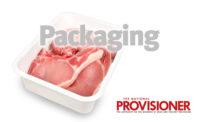The U.S. meat market was valued at approximately $68 billion in 2013 and is projected to reach $84 billion by 2018, according to Canadean’s 2015 “Consumer and Market Insights: Meat Market in the U.S.” report. In the face of this anticipated expansion, meat and poultry processors will face increased pressure to identify ways to remain competitive while also catering to consumers’ ongoing preference for high-quality, environmentally responsible and visually appealing food products.
In response to this pressure, many processors are turning to flexible solutions that can improve these attributes. In fact, according to The Freedonia Group Inc. World Pouches 2014 study, global demand for flexible packaging pouches will reach $37.3 billion by 2018 — a projected 6.2 percent annual increase.
Stand up, stand out
Stand-up flexible pouches effectively combine the best attributes of flexible and rigid formats to offer several advantages. Brand managers can use the format as a way to differentiate their product on the shelf: There’s a wide range of printing effects available for flexible pouches, and the ability to print fully across the panels on a stand-up pouch also gives brands more room for messaging and eye-catching graphics. Clear windows can showcase the product itself.
We have already seen stand-up pouches in application in the frozen chicken segment, and according to the April 2015 “U.S. Meat, Poultry and Seafood Packaging Market” study by Report Linker, the use of stand-up pouches should grow in frozen meat, poultry and seafood applications. Stand-up pouches are also used for fresh hot foods — such as rotisserie chicken — and snacks including beef jerky products.
Extend shelf life
According to Mintel’s 2014 Food Packaging Report, 92 percent of respondents believe packaging’s most important attribute is the ability to preserve freshness. Flexible meat packaging can extend shelf life, a huge consideration for food retailers.
For example, vacuum packaging keeps the meat free from the negative effects of oxygen. Products are placed in the film and, as it is sealed, air is removed from inside the package. As the level of oxygen in the packaging is reduced, it inhibits the ability of microorganisms to grow and spoil the product.
Indicate freshness with smart solutions
Flexible packaging formats are also growing smarter. Some meat processors integrate intelligent indicators into flexible packaging to communicate a product’s freshness and reassure quality. These technologies include gas sensors, oxygen sensors and biosensors, as well as integrity, freshness and time-temperature indicators. Time-temperature indicators are small tags or labels that track the time-temperature history of a perishable product to indicate clear, continuous and irreversible reaction to changes in temperature. An intelligent indicator could be a sticker on packaged meat product that changes color if the meat goes bad. In this way, applications of intelligent indicator in the meatpacking industry can ensure the quality of highly perishable foods like fish and meat.
Enhance sustainability
Another advantage of lightweight flexible packaging is its potential to aid source reduction efforts to reduce carbon footprint – and ultimately, associated costs. According to the Flexible Packaging Association, the format uses less energy to manufacture than other packaging types. Use of flexible packaging can also significantly decrease the solid waste by weight introduced in landfills when compared to rigid dome packaging. Essentially, it helps to create more value for meat brands while improving their sustainability efforts.
PACK EXPO Las Vegas 2015
To explore new opportunities in flexible solutions as well as seeing the latest developments in packaging and processing, attend PACK EXPO Las Vegas (Las Vegas Convention Center; Sept. 28–30, 2015). Visit www.packexpolasvegas.com for details!





Report Abusive Comment